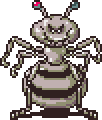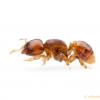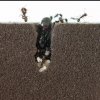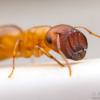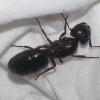I recently caught a queen Ponera pennsylvanica. I've attempted to search around for info on how to raise this species, but I can not find much. There is no Care Sheet or any detailed post detailing all of the info needed to raise this species. I've been able to glean a bit from other posts on this forum, but most of those posts only address a single issue that the OP was having.
What I've been able to find out so far:
a.) they do not form "large colonies"; 100 workers is considered a big colony for this species
b.) They live in the top layer of the soil and/or in hollowed out decaying wood/acorns.
c.) They seem to need soil present for them to sculpt the nooks and crannies that they will nest in; they will not just found in a glass test tube with a damp cotton ball (like many species)
d.) They are not claustral; the queen will (and should) forage while she is starting the colony up
e.) Several mature queens and males will be present in most colonies; the males mate continually with the queens throughout their lives (similar to termites, but with multiple males and not just a single "king" as is the case with termites)
f.) Queens and males are "ergatoid" meaning they have the appearance of a worker ant.
g.) The species is cryptic, meaning it is difficult to describe with certainty the morphological features that are to be expected when attempting to ID this species. Form and coloration vary depending on region/local genetics.
h.) The species is a meat eater and does not require sugar/honey/carbohydrates, though they may accept them if offered.
Please tell me --how much have I gotten correct? how wrong are the above statements? This was info I collected from various sources (from several different websites) over the past few days. I'd like to be sure of things, before I continue on attempting to get a colony of Ponera pennsylvanica going.
A care sheet on this species would be much appreciated if anyone out there believes they have the expertise to weigh in. If not, I have a series of questions regarding Ponera pennsylvanica that I'd like answered regarding their upkeep (and forgive me, but I am making the assumption that the above statements [a.-h.] I've made regarding this species are correct):
1.) Do I really need to provide them with soil to found a colony? Would sand work?
2.) If I took a Dremel tool or small drill bit and bore holes into perfectly "good" (non rotten) acorns, could I get them to found within an acorn? Has anyone tried this?
3.) If I only have one queen, will I be able to get a colony going? Or do I need to have at least one male (presumable of a different gene pool) present as well, since the males do not die immediately after mating and hang around for the life of the colony?


